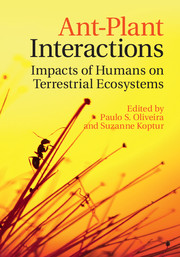Book contents
- Ant-Plant Interactions
- Ant-Plant Interactions
- Copyright page
- Contents
- Contributors
- Preface
- Part I Landscape Mosaics, Habitat Fragmentation, and Edge Effects
- Part II Ant-Seed Interactions and Man-Induced Disturbance
- Part III Ant-Plant Protection Systems under Variable Habitat Conditions
- Part IV Effect of Invasive Ants on Plants and Their Mutualists
- Part V Applied Ant Ecology: Agroecosystems, Ecosystem Engineering, and Restoration
- 16 Services and Disservices of Ant Communities in Tropical Cacao and Coffee Agroforestry Systems
- 17 Ant-Plant-Herbivore Interactions in Northern Neotropical Agroecosystems
- 18 Leaf-Cutting Ants in Patagonia: How Human Disturbances Affect Their Role as Ecosystem Engineers on Soil Fertility, Plant Fitness, and Trophic Cascades
- Part VI Perspectives
- Index
- Plate section
- References
17 - Ant-Plant-Herbivore Interactions in Northern Neotropical Agroecosystems
from Part V - Applied Ant Ecology: Agroecosystems, Ecosystem Engineering, and Restoration
Published online by Cambridge University Press: 01 September 2017
- Ant-Plant Interactions
- Ant-Plant Interactions
- Copyright page
- Contents
- Contributors
- Preface
- Part I Landscape Mosaics, Habitat Fragmentation, and Edge Effects
- Part II Ant-Seed Interactions and Man-Induced Disturbance
- Part III Ant-Plant Protection Systems under Variable Habitat Conditions
- Part IV Effect of Invasive Ants on Plants and Their Mutualists
- Part V Applied Ant Ecology: Agroecosystems, Ecosystem Engineering, and Restoration
- 16 Services and Disservices of Ant Communities in Tropical Cacao and Coffee Agroforestry Systems
- 17 Ant-Plant-Herbivore Interactions in Northern Neotropical Agroecosystems
- 18 Leaf-Cutting Ants in Patagonia: How Human Disturbances Affect Their Role as Ecosystem Engineers on Soil Fertility, Plant Fitness, and Trophic Cascades
- Part VI Perspectives
- Index
- Plate section
- References
- Type
- Chapter
- Information
- Ant-Plant InteractionsImpacts of Humans on Terrestrial Ecosystems, pp. 356 - 376Publisher: Cambridge University PressPrint publication year: 2017
References
Literature cited
- 1
- Cited by

